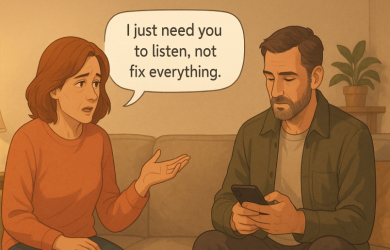8 Ways to Resolve the Differences in Male and Female Communication Patterns

Unlock Daily 30-Sec Tips for a Happier Relationship
👉 Subscribe FREEKey Takeaways
Marriage.com AI Quick Summary
How we communicate with others often begins with our family of origin, our first family, which provides a template that becomes our foundation.
In relationships, the ways in which two people communicate tells us a lot about how couples attempt to resolve a conflict. These communication patterns become a ‘dance’ between two people.
According to John Gottman, Ph.D., the tendency for men to withdraw and women to pursue is wired into our physiological makeup and reflects a basic gender difference.
Women tend to be the Pursuer and the men tend to be the Distancer
Women tend to be the Pursuer, wanting to engage in communication and continue to try and talk it out, despite the futility at the time.
They will do this until their needs are met.
Men tend to be the Distancer, they want to flee the argument and run to their man cave.
They run when they feel pursued. They want to avoid conflict. Many need space and time, a cooling off time to focus and process.
The Pursuer doesn’t see it that way and they certainly don’t feel that way. They want to connect now and figure it out now. They often become increasingly critical. Whatever way you slice it, it’s not a dance you want to continue.
These patterns of interaction are fostered due to one or both partners’ limitations in effective communication skills, as well as not being able to understand, identify, own, and express their feelings of fear and vulnerability.
Both partners feel equally vulnerable
Often times each person has fears that the relationship will not work out even if expressed differently, that their partner will not have their back and be available, that they will not feel safe in their relationship and that their safe haven is being jeopardized.
These all make people feel equally vulnerable.
Each partner reverts to their role of the distancer or pursuer
Couples often get stuck in communication patterns with little chance of resolving because when there is conflict or a disagreement, they each revert to their role of the distancer or pursuer.
This only increases their frustration. For example, one partner who is seeking security as a way to reduce their anxiety reaches for the other in their attempt to want more contact.
Their partner feels overwhelmed and actually responds in the opposite of what the other needs, they create space and withdraw to relieve their anxiety.
Unfortunately, many couples who fall into this pattern early in marriage do not make it to their fifth anniversary, while others are wired in it indefinitely!
8 Ways to resolve this pattern and create a healthier relationship:
1. Know your communication style
Have a conversation about your own first family and how your parents and other family members communicated with one another. Know and understand your communication style. Look for differences and similarities. Have that conversation.
2. Create greater safety and trust
Build a foundation. Begin with a soft startup, is this a good time to talk?
Create a dialogue about how you both want to create greater safety and trust in the relationship.
This means honoring how each person feels even if you disagree. This allows each person to feel ‘safe’ that they can share how they feel.
3. Recognize patterns
Are there certain trigger words? Are there certain times that you feel more overwhelmed or need to continue to have the conversation.
Observe the process of communication within the relationship, not the content or the topic. The goal is not to figure out how to manage every topic of discussion, but to create a different process that will allow each of you the opportunity to change how you communicate with one another.
4. Have a plan
Recognize and examine when moments of disconnection occur.
Start to slow down the “spin cycle” so you can give it closer examination. For example, plan to take a timeout. When both people are flooded with emotions your brain is literally on overdrive.
By taking a timeout, say 30 minutes or so couples can decrease their anxiety and start to talk about the issue at hand again. However, come up with a plan before you start to argue or when there are moments of calm when cooler heads prevail, and they are at a good place.
5. Alternative communication
For example, I am not a huge fan of texting, especially something serious and in depth – however, if people limit themselves to only talking to one another in person, they may feel very frustrated, especially in the beginning.
Some people do better at email which gives them the time to share feelings. You can use this a springboard to deeper conversations. Some couples start a journal together as they learn how to communicate in more effective and healthy ways.
6. Have a ‘we’ attitude
Nothing creates greater intimacy and a stronger relationship when both people feel and say they are on board.
They also recognize they may have many ‘fits and starts’ and that’s ok but if they both feel they are in this together and want to find a way out of their unhealthy ‘dance’ they have created, that speaks volumes!
7. Manage your own emotions
In times of stress, we are flooded with emotions. Each person needs to have the emotional bandwidth. It’s not your partner’s job to manage your emotions.
8. Stay on topic
Nothing says let’s fight more by bringing up all the issues that you feel are still unresolved. When you are in the midst of a discussion, stay on topic. By choosing one thing to discuss and leaving the other issues to another time, will help each person stay on task. And by the way, this can also be part of your plan!
Eventually, you and your spouse or partner will be at a better place, one in which you can stay in the conversation, recognize your triggers, and decide to stay connected!
Over time, a stronger relationship will evolve, one that you both believe can and will stand the test of time and feeling better about you communicate with one another.
 Tips
Tips
Write your tip or submit a video tip
All tips are reviewed before the publishing.
Share this article on
Want to have a happier, healthier marriage?
If you feel disconnected or frustrated about the state of your marriage but want to avoid separation and/or divorce, the marriage.com course meant for married couples is an excellent resource to help you overcome the most challenging aspects of being married.
Related Articles
Recent Articles
Related Quizzes
Unlock Daily 30-Sec Tips for a Happier, Healthier Relationship
👉 Subscribe FREE on YouTube We'd love your feedback!
We'd love your feedback!
 Expert Q&A
Expert Q&A
Ask your question related to this topic & get the support you deserve from experts.


















 Thanks for your feedback!
Thanks for your feedback!